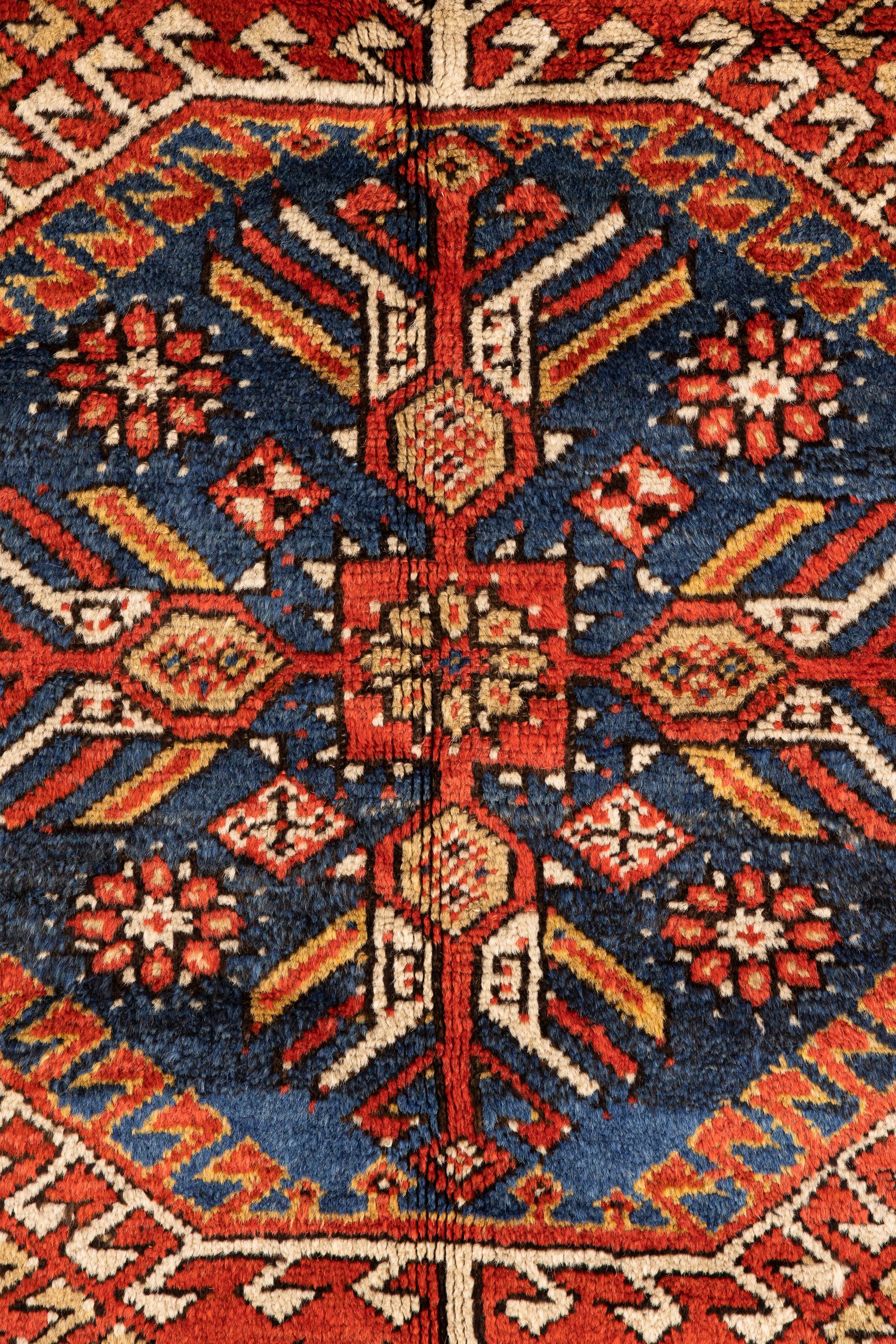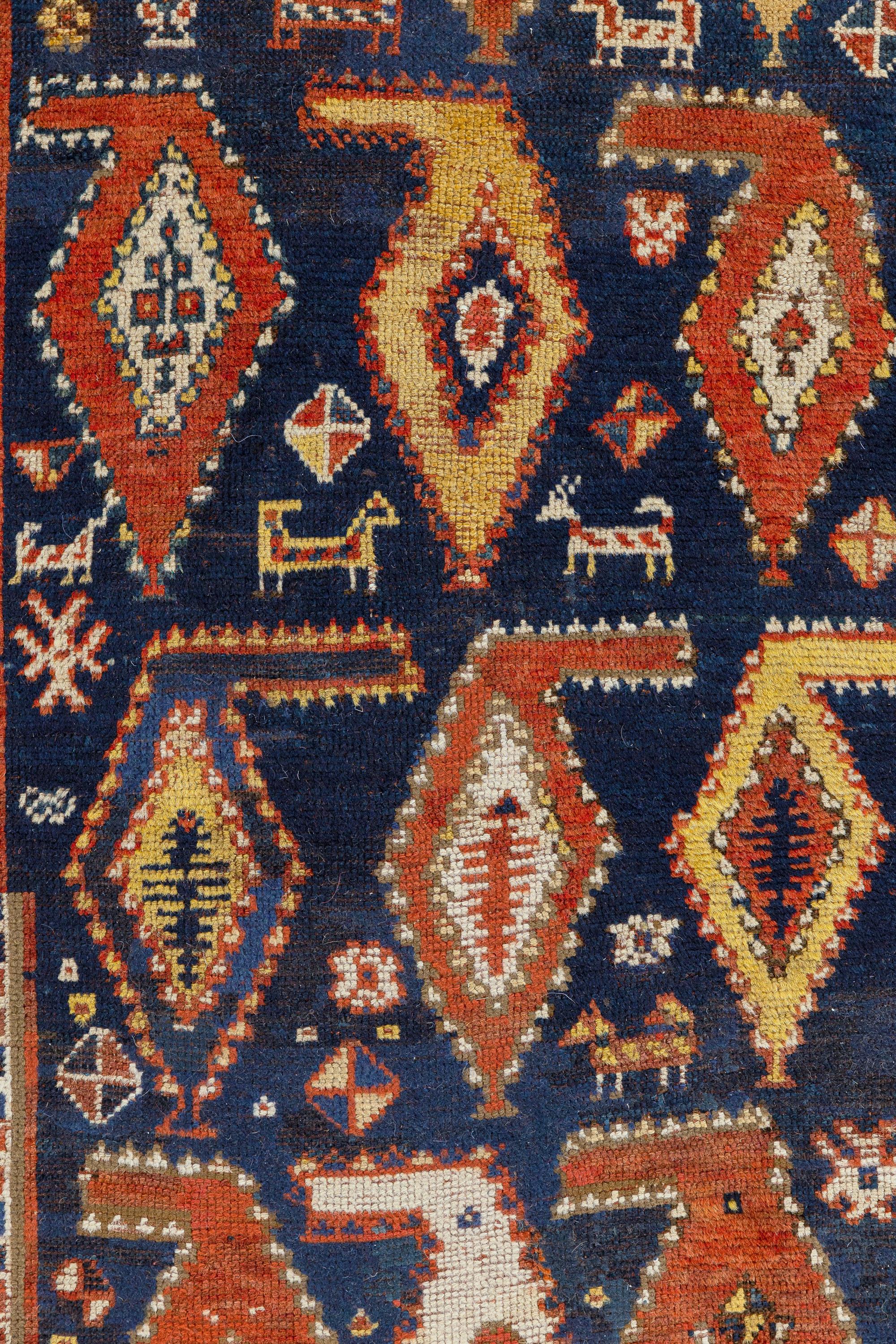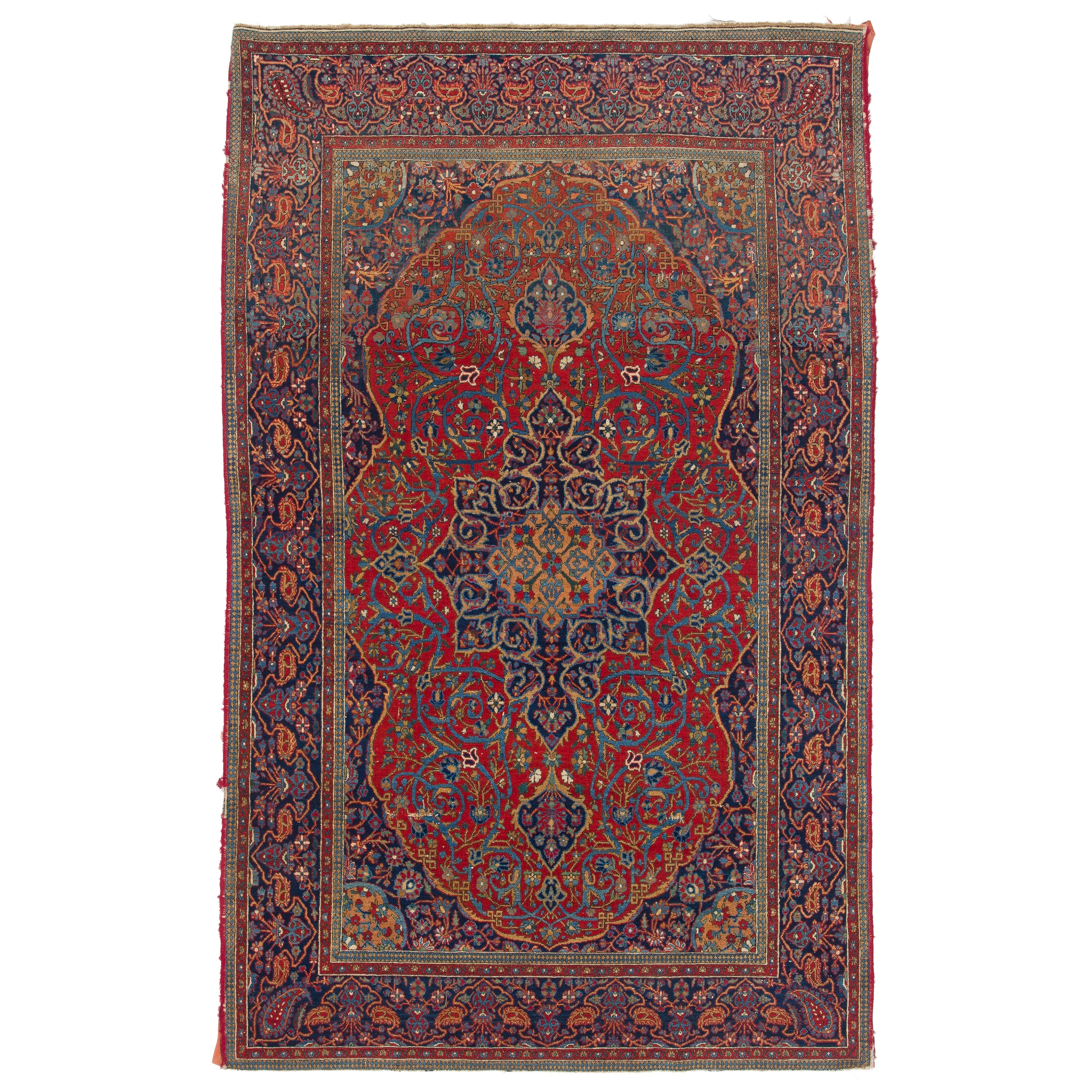Items Similar to 19th Century Antique Lavar Kerman Carpet
Want more images or videos?
Request additional images or videos from the seller
19th Century Antique Lavar Kerman Carpet
About the Item
Kerman Lavar – Southern Persia
This magnificent Kerman Lavar features a design that catches the eye for its intricate floral motifs and use of plenty of colours. The carpet has a rich design that resembles a multicoloured garden with palm leaves and flowers on the sand-coloured field with warm shades. The wealth of details of this sumptuous Kerman Lavar provides a semblance of royalty to any ambience. Its design is a perfect match for classic furniture. You could easily imagine this large rug in the living or dining room of a traditional or historic house or a library. In a contemporary room, this Kerman Lavar will make a nice contrast with furniture with straight lines and basic shapes. No matter how you use it, this piece will add character and grandeur to your space. The carpet is clean and ready for use.
None of the Persian rugs are more elegant and refined than the antique Kerman ones. Their quality and traditional floral designs make them ideal for those wanting to add elegance and glamour to their home design.
Kerman or Kirman was considered a centre for producing high-quality rugs in central southern Persia. Kerman rugs have designs inspired by rugs produced for the Persian court, made under the royal patronage of the Safavid dynasty over 400 years ago. An awe-inspiring fact is that 2010 a 17th-century Safavid Kerman was sold at auction for $9.6 million.
Located in the great desert of southern Persia, Kerman was an important trading and weaving centre even before the great explorer Marco Polo came along. The city was a must for travellers and merchants on the Silk Road.
Kerman rugs were among the first Persian rugs to reach the West, where they were avidly sought after in Europe. In the late 19th century, they were among the most distributed rugs in the United States. However, by the beginning of the 1920s, Kerman rug designs became simpler, with a less varied colour palette, thicker pile, and fewer knots, primarily in response to demand from the American market.
The success of Kerman rugs in the West was due to Kerman’s weavers being influenced by European culture. From the 18th century onwards, they developed a soft, graceful style that combined elements of Persian court rugs with the colours and designs found in French fabrics.
In the early 19th century, during a period of civil unrest, the city of Kerman was sacked and burned. The most skilled weavers fled to the village of Lavar (or Ravar), north of Kerman, where they established their looms. Lavar artists created delicate, finely woven pieces using a silky cotton-based wool. The finest antique Kerman rugs became known as “Kerman Lavar”.
Kerman Lavar rugs have a complex and subtle design that is unique to Persian weaving. The details of the floral motifs are graceful and poetic. They are made with a central medallion surrounded by dense foliage. The wool’s fine weave and excellent quality enabled artists to produce small-scale designs, making flowers and vines with smooth and flowing curvilinear lines. The pile used in antique Lavar rugs has high definition and a stunning finish.
The colours used in Kerman Lavar rugs are very soft, delicate, refined and graceful. Ivory and sand tones predominate and are rarely used in other Persian rug styles of the 19th century. Weavers then had access to the expensive cochineal dye, which allowed the production of a renaissance-hued red found in ancient Kerman rugs instead of the rust red used in most Persian rugs. The use of gold, saffron, and soft yellows connect in small areas with indigo, as well as a variety of pink tones, greens, and soft blues, which give Kerman Lavar a sublime colour palette.
Lavar rugs reflect mastery in the making and skills of the artist and are made with the best materials. Within the Lavar group, you can find the best of the best by recognizing specific characteristics that distinguish them from the typical Kerman Lavar. It must be made from an excellent weave and finest quality pile derived from lamb’s wool rather than the sheep’s wool used in most antique rugs. Furthermore, the best of Kerman Lavar features exquisite details in their design, with many borders that produce a grey tone effect for the viewer. It also brings an attractive shine to the surface. The skillset of the Kerman weavers is substantial. Their hard work, ambition, and dedication to art are respected worldwide.
Today, although alluding to a village, the term “Kerman Lavar” is used in the antique rug market almost exclusively to denote the best quality of Kerman rugs, considered among the finest handmade rugs ever woven in Persia. Lavar rugs produced in the 19th and early 20th centuries are rarely available today. They are trendy and sought after by connoisseurs and collectors in Europe and America for their impressive artistic impact. They are excellent for investments in art, a trend now gaining strength.
The delicacy and variety of Kerman rugs give the interior designer great flexibility. The high quality of the finest Kerman rug makes these pieces ideal for composing formal and classic interiors. However, it is equally desirable in modern interiors. Kerman rugs provide designers with a variety of options. There is a perfect Kerman rug for every type of space, whether complex or minimalist. They always bring elegance, timeless beauty, and a magnificent work of art to your space.
- Dimensions:Width: 122.84 in (312 cm)Length: 163 in (414 cm)
- Materials and Techniques:Wool,Hand-Knotted
- Place of Origin:
- Period:
- Date of Manufacture:Circa 1875
- Condition:Reduced ends.
- Seller Location:Barueri, SP, BR
- Reference Number:1stDibs: LU9788239492622
About the Seller
New to 1stDibs
Joined in the past six months.
No Reviews Yet
Vetted Seller
These experienced sellers undergo a comprehensive evaluation by our team of in-house experts.
1stDibs seller since 2024
- ShippingRetrieving quote...Ships From: Barueri, SP, Brazil
- Return PolicyA return for this item may be initiated within 7 days of delivery.
Auctions on 1stDibs
Our timed auctions are an opportunity to bid on extraordinary design. We do not charge a Buyer's Premium and shipping is facilitated by 1stDibs and/or the seller. Plus, all auction purchases are covered by our comprehensive Buyer Protection. Learn More
More From This SellerView All
- Antique Kerman CarpetLocated in Barueri, SP, BRKerman – South of Persia This rare and unique rug exhibits a design influenced by Indian aesthetics. The carpet comprises six arches between bordeaux and dark cyan colours, supporte...Category
Early 20th Century Persian Persian Rugs
MaterialsWool
- 19th Century Antique Persian Serapi CarpetLocated in Barueri, SP, BRSerapi – Northwest Persia This antique Serapi of high artistic calibre features vibrant colours around the large central medallion in blue and salmon on a red background. Every rug ...Category
Antique Late 19th Century Persian Persian Rugs
MaterialsWool
- 19th Century Antique Persian Serapi CarpetLocated in Barueri, SP, BRSerapi – Northwest Persia The finest 19th-century Serapis, like this one, perfectly woven and in incomparably good condition, reflect a breathtaking level of originality and perfect...Category
Antique Late 19th Century Persian Persian Rugs
MaterialsWool
- Antique Persian Kerman CarpetLocated in Barueri, SP, BRKerman – South Persia This luxurious medallion Kerman is made with flowers and vines in the centre of the navy-blue field of the rug. The highlight is the abrash technique used with...Category
Early 20th Century Persian Persian Rugs
MaterialsWool
- Antique Kerman Carpet Palatial SizeLocated in Barueri, SP, BRKerman – South Persia A magnificent Kerman rug with a paradise design of palatial proportions. It features infinite birds and animals among a profusion of trees, flowering plants, a...Category
Mid-20th Century Persian Persian Rugs
MaterialsWool
- 19th Century Antique Persian Serapi Palatial Size CarpetLocated in Barueri, SP, BRSerapi – Northwest Persia This ancient Serapi was exquisitely made with the highest artistic and quality materials. It is a piece with perfect aesthetic balance. The central medalli...Category
Antique Late 19th Century Persian Persian Rugs
MaterialsWool
You May Also Like
- Late 19th Century Lavar Kerman CarpetLocated in Closter, NJThe city and province of Kerman is geographically isolated in the great desert of southern Persia. An industry of both shawl and carpet production has flourished there since the Safa...Category
Antique Late 19th Century Persian Kirman Persian Rugs
MaterialsWool, Cotton
- Late 19th Century Antique Persian Lavar Kerman Carpet, circa 1980sLocated in New York, NYThe pattern of cartouches stretches out towards one end, indicative of an early carpet before exact scale paper cartoons were the usual Kerman practice. The dark blue, pale blue and ...Category
Antique 1880s Persian Kirman Persian Rugs
MaterialsWool
- Antique Lavar Kerman carpetLocated in New York, NY19th Century Persian Sultanabad Carpet 10.8x14.4Category
Antique 19th Century Persian Persian Rugs
MaterialsWool, Cotton
- 19th Century Lavar CarpetLocated in Chicago, ILA 19th century Persian Lavar carpet with central medallion on a pink background framed by floral and vine motifs, surrounded by a compound contrasting bor...Category
Antique 19th Century Persian Persian Rugs
MaterialsWool
- Antique Persian Lavar Kerman CarpetLocated in New York, NYAn antique Persian Lavar Kerman carpet from the early 20th century.Category
Early 20th Century Persian Tabriz Persian Rugs
MaterialsWool
- Antique Persian Lavar Kerman CarpetLocated in New York, NYLavar Kermans often show all-over patterns such as this with an ivory ground and ragged rosettes in a broken, diamond lattice array. Palmettes and forked leaves are among the importa...Category
Antique Early 1900s Persian Kirman Persian Rugs
MaterialsWool





